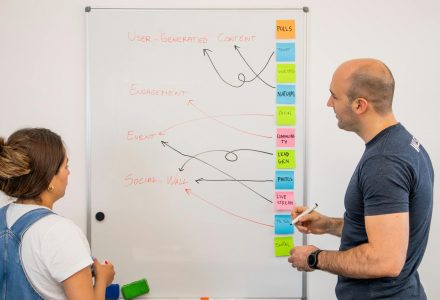B2B (business to business) marketing is a unique ballgame that can be completely different from its B2C (business to consumer) counterpart. Yes, we are still technically marketing our products to people, but there are a lot of major differences between these two types of markets, and so B2B marketing has its own challenges and perks.
A common saying is that B2B marketing is more about winning the market’s logic, while B2C marketing is about touching the consumer’s emotion. So, in B2B marketing you’d want to focus on convincing the customers logically about the benefits of the product/service. It’s rare for B2B buyers to use personal emotions involved in the purchasing decision (since it’s the company that is going to buy some things).
So, we’d want to focus on understanding the buyers (both the organizations and the stakeholders), their needs, and how your product/service can help the business.
Here, we will discuss all you need to know about B2B marketing, but let us begin by further discussing the key differences between B2B and B2C.
B2B vs B2C Marketing
Although, as discussed, there are so many differences between B2B and B2C marketing, these differences can be boiled down into four major ones: the parties involved, objectives, factors affecting purchase decisions, and sales cycle.
1. Who Is Involved In the Process
A major difference between B2B and B2C marketing is who is going to make the purchase decision.
In B2C, if, for example, we are selling a smartphone, then we only have to convince this specific consumer for the purchase (in turn, they might need to convince their parents, spouse, etc., but the purchase decision is mainly theirs.)
The process is much more different in B2B sales. An employee or someone in the purchasing department might stumble on our product and are interested in a purchase, but then they must ask the approval of their boss, finance manager, CEO, and probably many other parties in the organization before the purchase is finally finalized.
So, in B2B marketing, our marketing campaigns must target all these different stakeholders that might be involved in the purchase decision. These stakeholders might have different roles, behaviors, needs, and pain points, which can add further complexities in creating custom-tailored marketing efforts to target each of these stakeholders.
2. Difference In Objectives
We have briefly discussed this above: the objective in B2B marketing is more about making logical arguments to build trust and long-term relationships, while B2C marketing is more about making emotional arguments to convince transactions.
But why is that?
The underlying principle is relatively simple: B2B buyers buy things because of problems faced by the organization or to improve the organization’s business process. On the other hand, although it’s also true in B2C purchases, we are more likely to be emotionally driven in purchasing B2C products.
So, when purchasing a B2B product/service, we are going to calculate the potential ROI of investing in the said product and whether the investment is going to be justified. This requires logical, tangible arguments from the B2B marketer.
3. Factors Affecting Purchase Decisions
There are at least three different factors affecting B2B and B2C purchase decision:
- The different stakeholders: we have discussed this above, but in B2B marketing we have to logically convince different decision-makers with different concerns, needs, and problems. B2B prospects would consider their peers and higher-ups before they are going to bring the potential of purchasing this product at a meeting.
- Education vs entertainment: in general, B2B businesses need to be educated and convinced while B2C consumers want to be entertained.
- Relationship quality: B2B marketing relies on how we can build long-term relationships, while B2C marketing focuses on short-term conversions. In B2B purchase decisions, it may take a long time before a business might decide if a vendor is worth working with.
Although we shouldn’t always generalize these things (i.e. B2B decision-makers also like to be entertained from time to time), the main principle remains the same: in B2B marketing we have to logically convince customers that their investment in our product/service is going to be justified, ROI-wise.
4. Sales Cycle
The B2B sales cycle is typically much longer than the B2C counterpart due to the reasons we’ve discussed above.
B2B marketing requires more lead nurturing in general, while also requiring closer attention to trust and relationship-building. Again, a reason why the sales cycle is long is due to the fact that we need to convince more than one decision-maker in the process. B2B customers might need to escalate every decision to other parties before the purchase finally happens.
We are going to delve more into this B2B buyer’s journey in the next section.
B2B Buyer’s Journey and Sales Cycle
By understanding the actual process of how a B2B purchase happens, we can better plan our B2B marketing campaigns according to our target audience’s needs. While the buyer’s journey might vary depending on your niche and/or business model, here are the typical phases in a B2B buyer’s journey:
Phase 1: A Prospect Becomes Aware of a Problem
The typical first phase in a B2B buyer’s journey is when someone in the target company becomes aware of a specific problem faced by the organization.
For example, if you are selling a SaaS solution for malware detection, an IT officer in your target company might have just learned that their system has been invested by malware, and is now searching for a potential solution.
Phase 2: Searching For Product/Service To Solve The Problem
With the same example, the IT officer is now researching online (via Google, for example) for the best anti-malware solutions available in the market. The IT officer might also ask his/her colleagues and friends, and in this phase.
B2B businesses can publish relevant, valuable content that might be informative for the prospects to capture them on this stage. For example, the IT officer might stumble upon a blog post from our company about malware detection and management.
Phase 3: Collaborate With Team Members on Research
This IT officer might also start informing their higher-ups (i.e. an IT manager) about the problem and/or might have brought this up in a meeting. They also start discussing the potential product solutions they’ve researched in phase 2 with their team members and colleagues.
In this stage, this prospect (or a team member) might start reaching out to sales representatives for further information about potential solutions. From a marketing point of view, more stakeholders might enter the picture in this phase.
Phase 4: Considering The Purchase
This is the phase where the prospect has figured out their problem and has narrowed down potential solutions, and they may have already found out your solution as a strong(est) candidate although they are still considering your competitors’ solutions.
In this phase, the marketer’s job is to prove that your product/service is the best solution for their specific problem, mainly via content marketing.
Phase 5: Making The Purchase
After all the considerations and comparisons, in this stage, the prospect has selected you as the final choice and is ready to purchase. The prospect might negotiate for a lower price, and all other stakeholders might be involved in this negotiation.
The goal for marketing and sales in this phase is to resolve their potential obstacles and objections rather than overcoming these objections. For example, by offering more flexible payment options (i.e. installments) or discounts when possible.
Phase 6: Post-Purchase Experience
In the B2B buyer’s journey, the product purchase is where the real journey begins. B2B marketers must continue to engage with the purchasing customers well after they’ve made the purchase, especially if the B2B business utilizes a recurring-revenue business model (i.e. subscription-based).
The customer might also share the purchase experience to their peers and colleagues and might recommend your product, turning them into advocates.
Marketers must continue providing ongoing support and service, while also looking for cross-selling and upsell opportunities while collecting and acting on feedback.
Top 7 B2B Marketing Strategies
Based on the buyer’s journey/sales cycle we have discussed above, now we can discuss the most effective B2B marketing strategies in 2021 and onwards.
Let us begin with the first one:
1. High-Conversion Website With Optimized UI/UX
In the B2B space, your business’s website is a very crucial asset you should have. It is your digital replacement of a storefront and can be the most important factor in convincing prospects that your business is credible and trustworthy.
Think about it, would you want to deal with vendors with clunky, unprofessional websites?
While website optimization can be a very broad topic to discuss, and we won’t give it much justice discussing it here, here are some important areas to consider:
- 57% of internet users admitted that they won’t recommend a business with poorly-designed mobile websites, so mobile-responsiveness is very important.
- Content is still king. No matter how beautiful and well-designed your website is, you’ll need relevant, high-quality content to attract and convince your prospects.
- Load speed. Make sure your website loads fast. According to Google, 50% of visitors will bounce from websites that load in more than 3 seconds.
- Make it as easy as possible for your visitors to convert, whether to sign-up to your newsletter or make a purchase. Include as few steps as you can and if you use forms, include as few fields as possible. Again, make sure all elements are mobile-friendly.
2. SEO
SEO (Search Engine Optimization) will be our main way of building awareness for our brand. As we’ve discussed in the buyer’s journey section above, we are going to attract prospects who are looking for information related to their company’s problem, and we have to ensure our content gets ranked on Google to tap into this opportunity.
SEO will be closely related to our #3 strategy, content marketing, so we will discuss them together below.
3. Content Marketing
Content marketing is the best way to establish your position as a credible vendor in your niche and as a thought leader in your industry. This is why in 2019, 78% of surveyed B2B companies admitted that they currently use content marketing.
The idea here is to use content marketing together with SEO to create what we call inbound marketing to attract prospects inwards rather than pushing our promotional messages outwards.
Regularly publish high-quality content that will answer your target audience’s problem and/or provide relevant information for your target audience. Don’t forget that nowadays there are various content mediums to use, from your traditional blog posts to infographics to YouTube videos to podcasts. Also, even with text-based content, you can use white papers, ebooks, and other forms besides a blog post.
Again, SEO will be the main way to promote your content, and getting backlinks remains the most important SEO ranking factor. Promote your content via all possible channels and aim to get backlinks in the process.
4. Paid Marketing
While inbound (content marketing) and organic traffic via SEO are much preferred, utilizing paid channels is still important. While organic traffic is much cheaper (if not totally free), it can take months and even years before you can generate significant results from SEO and content marketing.
The idea here is to use paid channels to buy some time and also help boost your inbound marketing performance. Consider:
- Google Ads, still very high click-through rate and of course, Google’s massive reach
- Social media ads. Linkedin and Facebook ads tend to deliver the highest ROI in the B2B space.
- 91% of surveyed executives admitted that LinkedIn is the first choice in finding content, so promote your content via LinkedIn’s paid options.
5. Conversion Rate Optimization
Conversion rate optimization, or CRO, is an effort to improve the likelihood of a visitor to complete a certain action on your B2B website, landing page or platform.
For example, if the desired action is for the visitor to sign-up to our email newsletter, then we can implement CRO to ensure all elements in our site are properly optimized to encourage this conversion.
While CRO can be a very broad subject covering many different elements to optimize, here are some of the most important optimizations to consider:
- Secure site: make sure to use SSL certificates (HTTPS) and ensure your site is 100% safe for your visitors. If there’s even the slightest hint that your site is not secure, it will significantly lower the conversion rate
- Page speed: make sure your site loads quickly in less than 3 seconds
- Clear header/title: make sure your visitors can understand the page’s content with one glance
- CTA placement and copy: avoid using the word “submit”, and don’t be boring. Be clear and to-the-point, and communicate the benefit of clicking the CTA (i.e. “ready to improve your sales by clicking here?”)
- Social proofs: if you have great client testimonials and reviews, put them somewhere easily seen
- Optimized forms: don’t use too many fields in your forms, and make sure it’s easy to fill the forms on mobile devices
In short, make it as easy as possible for your visitors to convert, and eliminate all potential obstacles.
6. Email Marketing
Even with all the new platforms and technologies, email marketing is still a very powerful marketing channel with a very high ROI of 122%. The secret here is to implement personalization and automation to send the right email to the right people at the right time. Utilize drip marketing strategy to implement segmentation and personalization with your email campaigns, and integrate your email campaign with your other strategies.
7. Account-Based Marketing
Account-based marketing (ABM) is a focused approach in B2B marketing strategy where your marketing and sales teams cooperate with each other to target the highest-value accounts to convert them into customers ASAP. The basic idea is to put all resources and efforts into the best-fit prospects to maximize ROI.
In implementing ABM, the general steps are:
- Identify a list of target accounts
- Research all accounts and determine the best-fit targets
- Create relevant, personalized for top-priority accounts
- Distribute content to the right person within the target company
- Evaluate the results and re-adjust if necessary
Highly-targeted sales and marketing campaigns in ABM can ensure we create a cost-efficient effort with a potentially high ROI
End Words: Do’s and Don’ts
While B2B marketing might seem complicated at first, it is actually pretty simple once you’ve got the hang of the buyer’s journey in the B2B space and how to use the insights in your campaigns. To end this article, here are some important do’s and don’t in implementing your B2B marketing strategy.
Do’s:
- Budgeting: obviously your B2B marketing objective is to make more money, so make sure you don’t spend more than you can gain.
- S.M.A.R.T Goals: set specific, measurable, attainable, relevant, and time-bound goals.
- Segment your focus: it’s more important to focus on campaigns that matter rather than investing on too many different channels at once. Consider your priorities
Don’ts:
- Use too much jargon: in your content marketing, write for the benefit of your audience and not to sound smart. Focus on providing value.
- Focusing too much on your brand: don’t focus on pitching how great your company/product/service is, but rather focus on how you can provide a solution for your customer’s problem
- Mobile-friendliness: more B2B buyers are researching products on their mobile devices, so make sure your website and content are mobile-friendly or mobile-responsive






